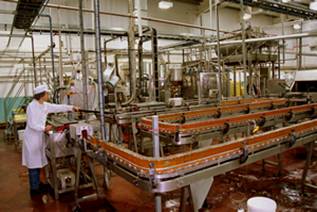Just-in-case (JIC) and just-in-time (JIT)
Just-in-case (JIC)
Traditional approaches to stock control rest on the basis of batch production techniques used in manufacturing. Raw materials are bought, processed and stored in batches. Not much emphasis is placed on establishing a flow of production, often as a consequence of relatively low, or inconsistent, demand patterns. Even in the world of modern, technology-based production, it is estimated that more than 90% of all manufacturing businesses in the world still subscribe to batch production techniques. This clearly has significant implications on the methods of stock control that they apply and their approach to lean production and quality assurance.

Just-in-case (JIC)
Just-in-case is a production and distribution system, with buffer stocks held at every stage in the production process 'just in case' there is a production problem or demand rises unexpectedly. Stocks of raw materials, components, work-in-progress and finished goods are held by the producer to ensure continuous production.
 The traditional approach to stock control is called a 'just-in-case' approach. This means that the firm holds buffer stocks of raw materials ready for production just in case they are demand or supply fluctuations. Holding minimum stock levels means that:
The traditional approach to stock control is called a 'just-in-case' approach. This means that the firm holds buffer stocks of raw materials ready for production just in case they are demand or supply fluctuations. Holding minimum stock levels means that:
- greater flexibility to meet customers' needs, even when there are unexpected changes in demand
- stock is ordered less frequently, reducing clerical and purchasing costs
- the firm can buy in bulk, and reduce unit purchase price by negotiating higher discounts (purchasing economies of scale)
- the firm can avoid stock-outs and the resulting production downtime
The just-in-case system is favoured by traditional manufacturers, but this approach does not sit well with quality assurance methods as there is no real incentive to achieve zero defects, since spare stock is held at all stages of the production process. Waste is the consequence of JIC and runs counter to the principles of Total Quality Management (TQM) and Lean production as developed by W Edwards Deming.
Just-in-time (JIT)

Just-in-time (JIT)
A management and manufacturing philosophy aimed at the total elimination of waste. JIT is designed to minimise the costs of holding stocks of raw materials, components, work-in-progress and finished goods by supplying to each part of the production process exactly what is needed, when it is needed and in the quantity it is needed. Critical components of the system include total quality management, lean production and employee involvement.
The JIT philosophy was developed following the second world war in Japan by Kiichiro Toyoda and embedded at the Toyota Motor Company by Taiichi Ohno. Moving to JIT from a more traditional production system such as just-in-case, requires a change in corporate culture, a different organisational structure and a more democratic management style.
With JIT production, an absolute minimum level of stocks is held with materials delivered, just as they are required and in the quantities needed. JIT is an element of lean production, running with minimal buffer stocks and relying on daily or even hourly deliveries from trusted suppliers. Since there is no bolt-on quality control in JIT, defects in components could bring the whole factory to a stop. Consequently, stocks and components supplies must have zero defects. Firms that operate JIT work with their suppliers to ensure that the whole supply chain employs consistent quality assurance methods and procedures.
The principle of JIT is that products should be 'pulled through' the factory, rather than 'pushed through'. In practice, this means that production should be to meet specific customer orders, not produced just-in-case. Finished goods are not kept in the warehouse, but delivered immediately to the customer. Overall, the need for working capital is reduced significantly.
 JIT working has led to the development and use of preferred suppliers, rather than manufacturers relying on competitive tenders. A good relationship between supplier and buyer is necessary so that suppliers are willing to make the necessary investment in quality systems and procedures. Some buyers even made direct investments in their suppliers. Teamwork is central to the JIT approach.
JIT working has led to the development and use of preferred suppliers, rather than manufacturers relying on competitive tenders. A good relationship between supplier and buyer is necessary so that suppliers are willing to make the necessary investment in quality systems and procedures. Some buyers even made direct investments in their suppliers. Teamwork is central to the JIT approach.
JIT is widely used in car assembly. The specific order from the customer is given an assembly slot, a number and a bar code. All the components are ordered to be available that day. They are given bar codes and organised to arrive at the appropriate assembly spot at the correct time. The specific car rolls off the assembly line on time. In fact, because each car can now be customised, buyers of Saab and BMW cars have recently been given the opportunity to see their own vehicle being manufactured. Using seven cameras in BMW's South Carolina plant, BMW deliver X3 customers with video that tracks their vehicle through the various stages of final assembly.
The system works because of the use of computers and bar codes, as well as the use of skilled and trained workers. Flexibility is key to the success of a JIT system. All the production team must be multi-skilled and are likely to be working as teams within production cells. This requires well-motivated employees who give the system and procedure their full support and co-operation.
Machinery too, must be adaptable and there is heavy use of Robotics in JIT production lines. Equipment will be laid out according to the work sequence. Quality is assured by keeping small inventories and through one-piece flow production, meaning one product moves from process to process, allowing production workers to make a complete inspection of every piece manufactured. Quality is considered to be everyone' responsibility and each employee has the power to stop the production line if a problem is identified. Trust is a vital requirement and managers must be prepared to delegate responsibility.
JIT is example of the interaction between methods, systems, procedures and people to ensure success.
Summary
Advantages of JIT
- reductions in the cost of holding stock
- space that was used for storing stock can be released for other activities
- minimal inventory releases cash flow for use elsewhere in the business
- reduces the chance of holding obsolescent stock with less chance of damaged stock
- allows a firm to lower its break-even point
- improved motivation and teamwork with more flexible and multi-skilled employees
- promotes customer focus and increased flexibility and responsiveness to individual customer needs
- allows for greater customisation in the production process
- greater focus on quality and zero defects and lowering of waste levels
- strengthens collaboration along the supply chain
Disadvantages of JIT
However, like many things in business, just-in-time is not a panacea for all ills. JIT may not be suitable for all firms as JIT has limitations and drawbacks:
- there is a heavy reliance on suppliers - any failures in delivery can lead to expensive production delays and stock-outs
- JIT does not cope well with sudden surges in demand
- lower stock order quantities does not allow for the same level of purchasing economies of scale as found in traditional stock control systems
- frequent small deliveries are likely to be expensive as there will be fewer bulk discounts
- administration costs are likely to be higher maintaining stock levels and ensuring no stock-outs
- JIT requires a change in management style - not all managers and workers are prepared to 'buy-in to the philosophy'
- training costs can be higher than traditional production systems
- JIT needs expensive computer technologies and robotics for its smooth operation
- Increasing global inflation, especially in components, makes the holding of stocks through forward buying beneficial
